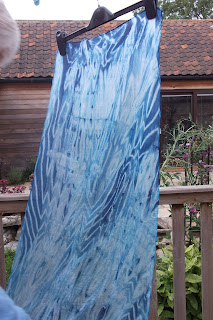All problems sorted and I hope that when I go on Monday to do a final ironing session and wash the scarves that everything is in place. My Show space is much better than I had initially envisioned and that's largely due to the experience of Fine Art tutors who 'do not display as much stuff as textiles'! So I have a larger area and that means that you can appreciate the individual pieces also with the help of our wonderful ladies in the Textile office displaying the pieces has been more successful. How I envied George whose work was on vinyl and upholstered sofa and chair when 2 men just spent an hour 'papering' the walls and the floor space lifted the furniture into place and that was it!! Her work is at the other end of the textile spectrum (if there is one) to mine and I think we respect each others professionalism!
The outcome of the Show may determine my enthusiasm to set up links for talks, demonstrations etc! Also the lack of response (which I think is rude!!!) from Elvedon, the Dean and the Heritage Officer has dampened my enthusiasm.
So watch this space but for now a Show I am proud of!!
 |
| HAND WOVEN COTTON SCARVES DYED WITH BLACKBERRY, WOAD, EUCALYPTUS AND INDIGO OVER WELD |
 |
| SILK SCARVES INCLUDING RUST ECO PRINT |













































